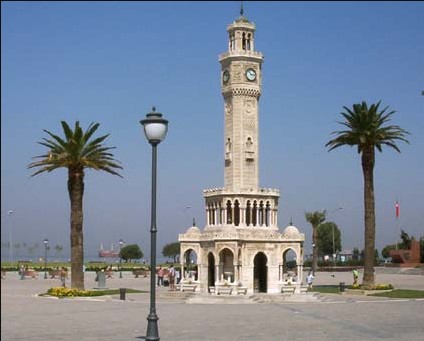
The city of Izmir is located in the Aegean region in western Turkey, at the gulf with the same name Izmir. Called as “the Peal of the Aegean”, is the third largest city and one of the most important commercial and industrial centre in the country. Izmir is also the second largest Turkish sea port.
Studies and excavations prove that Izmir dates back to 3000 B.C. During the ancient times Izmir was known as Smyrna and was initially built on the Tepekule site today as Bayrakli. Later, in the Turkish era the city of Smyrna was re-named Izmir…
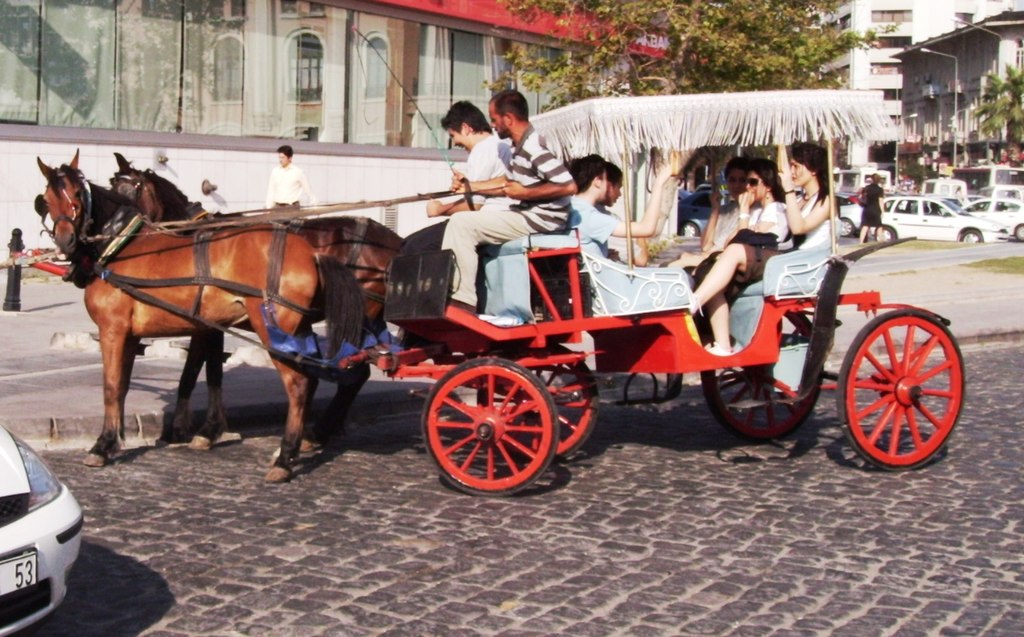
Table of Contents
Izmir Weather (5 Days Gov. Forecast)
You may find below the weather in İzmir for the current day and for the following 5 days from Turkish State Meteorological Service Official Web Sites.
Time in Izmir
What time is it in Izmir? It is very easy to find calculating the time difference btw your location and Izmir time.
Izmir time is; (GMT+02:00) Athens, Bucharest, Istanbul; Europe/Istanbul
Here you may compare your local time with the local time in Izmir.
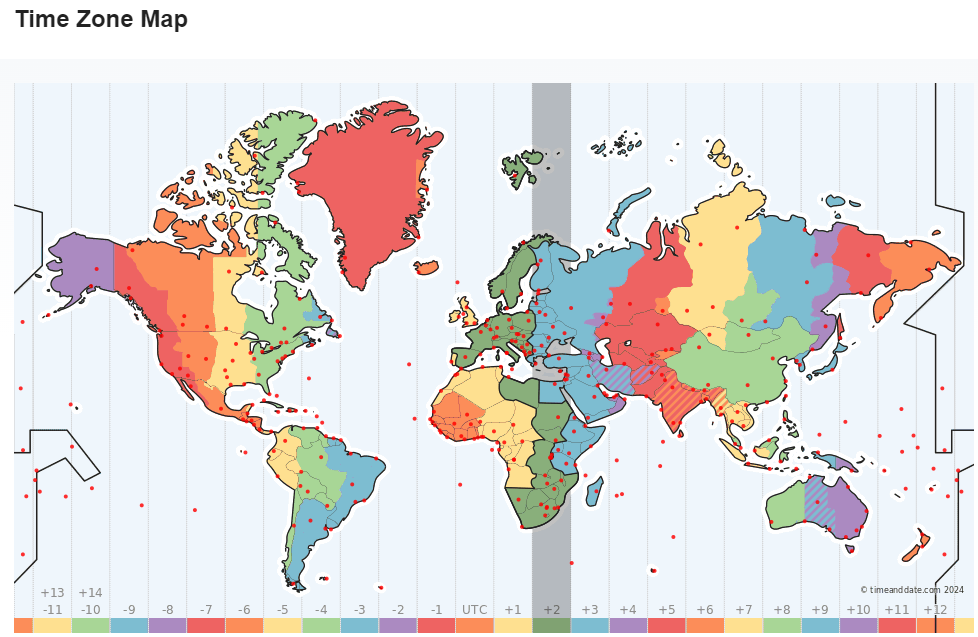
GENERAL INFORMATION
Izmir, Turkey’s third largest city, is a modern, developed and busy commercial center. Strolling around the bustling shopping center is quite enjoyable. To the west of Izmir lies the Çeşme Peninsula with its beautifully colored sea, beaches and thermal centers. Ephesus, one of the most famous cities of ancient times, was one of the largest cities in the world in Roman times. Ephesus, which embodies the richness of the entire Ionian culture, was also known for its intense artistic activities.
Izmir, called “Beautiful Izmir” in Turkish, is located at the head of a long and narrow bay surrounded by yachts and ships. It has a mild climate and in the summer a fresh cool breeze from the sea washes away the heat of the sun. There are palm trees and wide avenues along the coast. Izmir Port is the second largest port after Istanbul. A vibrant and cosmopolitan city, Izmir is also important for its International Art Festival and International Fair.
MUST SEE PLACES & MUST DO THINGS IN IZMIR


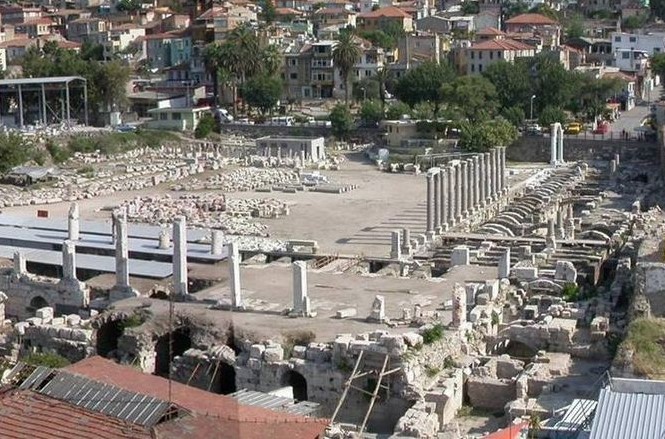
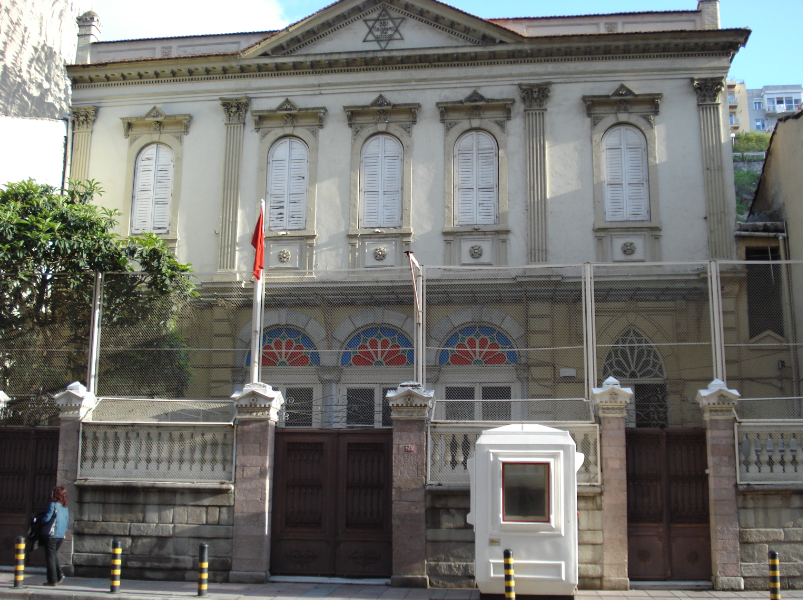
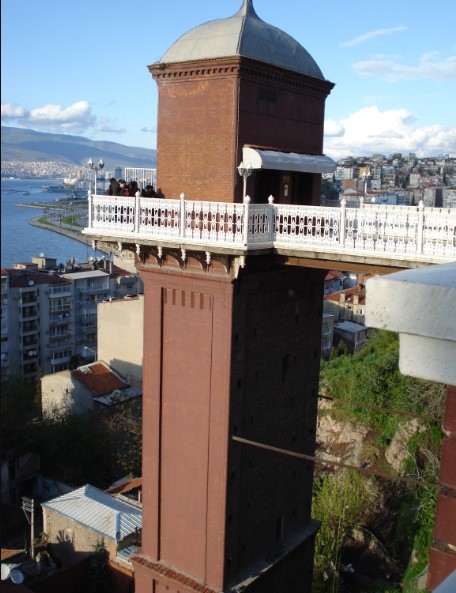

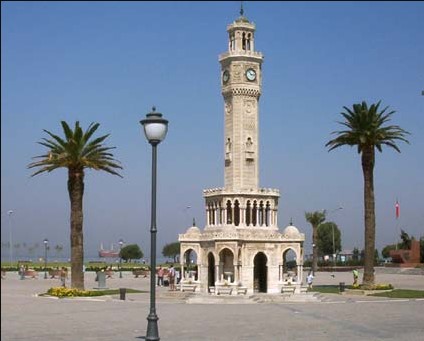


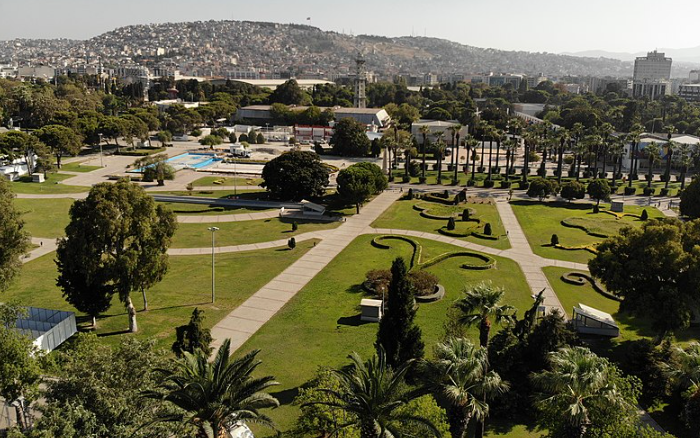

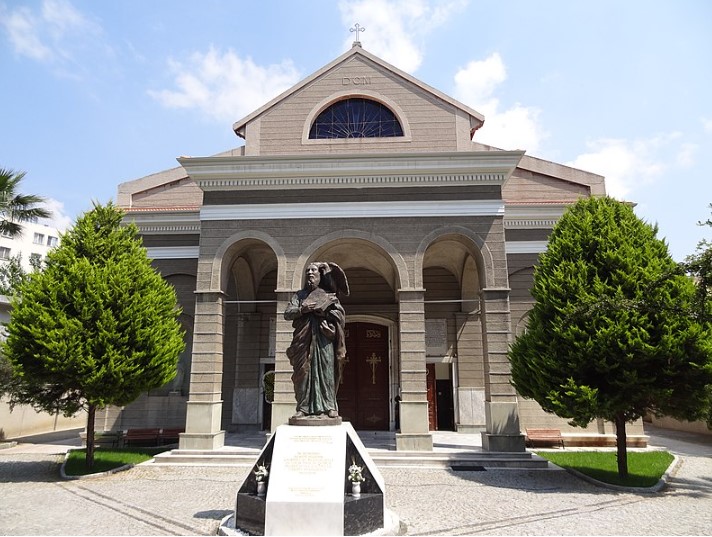

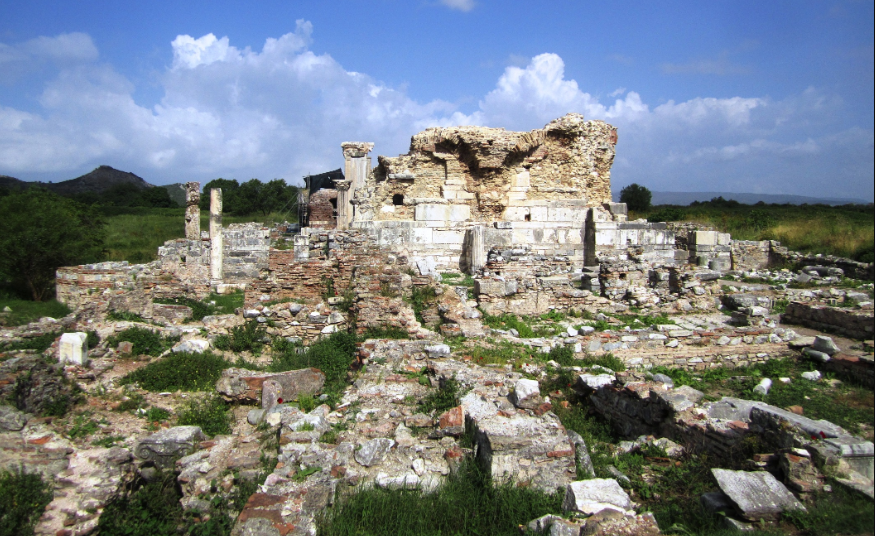
Must See: Selçuk-Şirince Village, Birgi Çakırağa Mansion, Kızlarağası Inn, HistoricalElevator,Izmir Archeology Museum, Izmir Atatürk Museum, Kordonboyu, Kemeraltı Bazaar, Cable Car Facilities and Balçova Hot Springs, Ephesus Ruins, House of Virgin Mary, Şirince Village, Pergamon Ancient City, Çeşme beaches, Izmir Fair and Selçuk Festival
Must Eat: Izmir Meatballs, Ödemiş Kebab, Boyoz (pastry), Kumru, Gevrek and the famous Gerdan dessert at Izmir Asansör Restaurant, Dried figs, sultaniye grapes, Kemalpaşa cherries, Bergama tulum cheese and lokma,Eating fish in Foça and Çeşme,
Must Buy: Ödemiş Silk (Pembizar), Needlework, Yemeni and Görece evil eye beads…
IZMIR GEOGRAPHY
Izmir is the third largest city in Turkey after Ankara and Istanbul. Izmir is a typical example of the Aegean coastal region. Surrounded by the Madra Mountains to the north, Kuşadası Bay to the south, Tekne Cape of Çeşme Peninsula to the west, and Aydın and Manisa provincial borders to the east, İzmir embraces the gulf that bears its name to the west.
Within the province of Izmir are the lower course of the Gediz River, one of the most important rivers of the Aegean Region, and the Küçük Menderes River. The indented and protruding coastline naturally results in the formation of countless beautiful bays and beaches.
The coasts and beaches of Gümüldür, Özdere, Foça, Karaburun, Çeşme are of great touristic importance for İzmir. On the other hand, the same natural structure has led to the formation of many fishing harbors or yacht berths. With these features, İzmir is a natural tourism and harbor city.
Large, hard and needle-leaved, evergreen, drought-resistant trees and shrubs that grow in the Mediterranean climate zone constitute the widespread natural vegetation.
Izmir is located in the Mediterranean climate zone with hot and dry summers and mild and rainy winters. The average annual temperature in the province varies between 14-18 ºC in the coastal areas. The annual average sea water temperature is 18.5 ºC.
HISTORY of IZMİR
The old city of Izmir was built on a peninsula located northeast of the gulf. The first settlement in the old Izmir mound, now called “Tepekule” near Bayraklı, dates from the 3rd millennium BC. This seaside mound, which was a small settlement at first, grew and developed a little more around the first core in the 2nd millennium BC. It is understood from the excavations that the 2nd millennium BC settlement is related to the Hittites.
In the 10th century BC, Bayraklı’s mudbrick-walled and flat-roofed houses are no different from today’s Central Anatolian villages. The city, which was under the rule of Lydia in 600 BC, Persia in the 5th and 4th centuries BC, was taken by Alexander the Great in 334 BC, and after these dates, it started to develop and become a big city on the skirts of the mountain where Kadifekale is located.
During the Roman Empire period, the city, which was severely damaged by the earthquake in 178 AD, was rebuilt and repaired. It became a major trade center during this period. It became an important episcopal center during and after the spread of Christianity during the Byzantine Empire, developed in the 5th-6th centuries AD, but lost its former importance in the years following the Arab raids in the 7th century.
Captured in 1320 by Gazi Umur of Aydınoğlu, the city became the capital of the Aydınoğulları Principality between 1402-1415 and was annexed to the Ottoman Empire by Mehmet Çelebi I in 1415.
DISTRICTS OF IZMIR
The districts of İzmir are Balçova, Çiğli, Gaziemir, Karşıyaka, Konak, Aliağa, Bayındır, Bergama, Beydağ, Bornova, Buca, Çeşme, Dikili, Foça, Karaburun, Kemalpaşa, Kınık, Kiraz, Menderes, Menemen, Narlıbahçe, Ödemiş, Seferihisar, Selçuk, Tire, Torbalı and Urla.
Aliağa :
Aliağa, 60 km. north of İzmir, bears traces of the civilizations of İzmir and Bergama. Aigaia, Kyme, Myrna and Gryneion are 4 of the 12 largest and most important of the Aeolian cities, which number more than 30 on the Aegean coast.
Dikili :
It is 120 km to the north of Izmir. It is a charming district that attracts local and foreign tourists. The touristic town of Çandarlı, which has both historical and extraordinary beauties, is connected to Dikili. Among its natural beauties, there is a crater lake in Merdivenli Village, pine groves and historical caves in Demirtaş and Deliktaş Villages. Dikili district is also very famous for its thermal springs. There are hot water springs in Nebiler, Bademli and Kocaoba villages. Apart from the highway in the district, Dikili Port serves in sea transportation with a capacity of three passenger ships.
Seferihisar :
The archaeological and historical resource potential of the district, which dates back to 1000 BC, includes the ancient city of Teos in Sığacık, Karaköse Ruins in Doğanbey-Gerenalanı, the castle built by the Ottomans in Sığacık and the old settlement area within the castle, and monumental buildings from the Seljuk and Ottoman periods in the district center. Seferihisar has 27 km of coastline with beautiful beaches and bays.
Menderes :
Drawing attention with its satsumas, beautiful bays and historical values, Menderes district is 20 km away from Izmir. There is Lebedos Ancient City in Ürkmez in the west of the district. The ruins of the ancient cities of Kolophon, Claros, Notion and Lebedos, located close to each other on the Menderes-Selçuk road, constitute important archaeological resources of the district.
The town of Gümüldür is the growing region of satsumas, the world-famous tangerine species. Özdere is one of the nine major touristic regions in the Aegean and is a touristic town where amateur fishermen can fish in addition to its clean sea and coast. In the village of Görece in Menderes, the beads of different colors and shapes produced by the people in the houses attract the attention of local and foreign tourists.
Karaburun :
Karaburun is located in the north of the Urla Peninsula. Along the Gulf of Izmir, the north and west coasts extend in a strip with beautiful bays. The settlement of the district dates back to the stone age. The finds from the excavations in Çakmaktepe indicate that this place was an advanced cultural center during the Hittite Period, and then the Aiol, Lydian, Hellenic and Roman civilizations dominated the region. It is known that it developed as a cultural and trade center during the Aeolian, Hellenic and Roman civilizations.
Urla :
Urla, which has all the characteristics of the Aegean Region, is located 38 km. to the west of Izmir, in the central part of the peninsula bearing its name. Urla has been a cultural center throughout history. Among the artifacts found during the excavations, a jug with a beak mouth belonging to the Hittites was unearthed. According to the finds from the excavations of the Limantepe Mound, it was revealed that the Klazomenai Port was the oldest and most organized harbor in the world. The artifacts found in Klazomenai are exhibited in the Louvre Museum, the National Museum of Athens and the Izmir Archaeology Museum.
Torbali :
The first settlement area of Torbalı, located 45 km. east of Izmir, is the ancient city of Metropolis, which was founded on a hill between Yeniköy and Özbey villages in the west of the Torbalı Plain. Metropolis, an Ionian city, maintained its importance during the Roman and Byzantine periods, but was later abandoned. Famous for its wines, the city was also a bishopric center. In the theater of the Late Hellenistic Period, which dominates the plain, there are three marble altars dedicated to the Roman Emperor Augustus and his son Germanicus. The artifacts found during excavations are exhibited in Izmir and Ephesus Museums.
Ödemiş :
The ruins of the ancient city of Hypaiapa in the north of Ödemiş, 113 km. east of İzmir, show that the settlement history of the region dates back to ancient times. The historical importance of the Ödemiş region started when Birgi became the capital of the Aydınoğulları period.
In Birgi, the distinguished examples of Seljuk and Ottoman architecture, the cultural accumulation formed by the civil architecture structures of the 18th and 19th centuries, the richness of the architectural environment and the beauty of the natural environment create a very important tourism potential in the region. Birgi, which was included in the “World Cultural Heritage” list, was included in the scope of faith tourism in 1994. Çakırağa Mansion, Imam-ı Birgivi Madrasah, Sultan Şah Tomb are among the works worth seeing.
Tire :
Tire, one of the largest districts of Izmir, is 82 km from the city center. It was established on the northern foothills of Aydın Mountains. Tire, which lived through the Hittite, Phrygian, Lydian, Persian, Hellenic, Roman and Byzantine periods, has a rich cultural heritage. During the Principalities and Ottoman period, great economic development was achieved and rich examples in terms of architectural history have emerged.
Kemalpaşa :
Located 29 km west of Izmir, Kemalpaşa dates back to 1300 BC. Kemalpaşa, which was the scene of many civilizations starting from the Akkadians and Hittites until the Seljuk and Ottoman periods, was a stopping point for caravan routes between Sart and Ionian cities during the Hellenic, Roman and Byzantine periods.
Today’s Kemalpaşa district, known by its ancient name Nymphaion, was established at an altitude of 200 meters on the slopes of Nif Mountain. Karabel Relief, the only remaining example of the Hittites in the Aegean Region, is within the borders of the district. Kemalpaşa is known for its world-famous cherries and pine forests.
HOW TO GO TO IZMIR
Highway : Intercity bus companies provide regular bus services to all provinces of Turkey day and night. The distance of the terminal to the center is 12 km.
Bus Station Tel : (+90-232) 472 10 10
Üçkuyular Bus Station: There are regular bus and minibus services to Çeşme- Seferihisar and Gümüldür districts in summer and winter. The distance to the center is 10 km.
Bus Station Tel : (+90-232) 259 88 62
Railway : There are regular train services from Izmir to cities such as Ankara, Istanbul, Denizli and Aydın.
Center Basmane Station, Tel: 0.232.484 86 38
Alsancak Station, Tel: 0.232.458 31 31
Seaway : Address: Izmir Port- Alsancak, State Railways Izmir Agency,
Other Ports; Çeşme Port, Dikili Port, Seferihisar-Sığacık Marina
Port Tel : (+90-232) 464 88 64 – 464 88 89
Airline : There are periodic flights to domestic and international destinations from Adnan Menderes Airport. The distance to the center is 16 km.
Airport Tel : (+90-232) 484 12 20
PLACES TO VISIT IN IZMIR
BERGAMA
Bergama, one of the oldest settlements in the history of our country’s civilization, located in the Bakırçay Basin, 100 km to the north of İzmir, has had archaeological artifacts of worldwide importance starting from prehistoric times and continuing with the Ionian, Roman and Byzantine civilizations.
Asklepion, one of the most important health centers of the Ancient Period in the southwest of Bergama, the Acropolis built on a 300 m. high steep hill, which was the first settlement area, and the Temple of Serapis (Red Courtyard) dating back to the 2nd century AD constitute the touristic attraction of the region. The Altar of Zeus was smuggled to Germany in 1897.
Bergama is a district famous for its beautiful thermal springs, the famous Kozak plateau, its connection to Ayvalık district famous for its beaches, and its advanced weaving and rug making.
History: Today’s name comes from the ancient name Pergomon. It was a great city with magnificent monuments in the early ages and the center of the kingdom of the same name, as well as an important strategic location in the Middle Ages, the center of Karesioğullari and finally one of the important centers of the Ottoman Empire.
According to the information obtained from the archaeological excavations carried out in the city, whose exact date of foundation is unknown, it was determined that the city walls were built in the 7th century BC and it is understood that urbanization started in these years. Bergama has seen the Persian, Alexander the Great, Phrygian, Thracian Kingdom, Seleucid Kingdom, Roman and Byzantine periods.
In 1302, after the Byzantine rule disappeared, the Karesioğulları Principality took over the administration of the city, and just after 1341, Bergama was taken by the Ottomans.
Climate Mediterranean climate is observed in the region. Summers are hot and dry, winters are mild and rainy.
Şirince Village
In the village of Şirince, which is estimated to have been a settlement area during the Eastern Roman Empire, some building remains have been unearthed. Tower ruins, aqueducts and monastery/church structures, which are thought to have existed since the 11th century, are the archaeological and historical resources that have survived to the present day in Şirince.
Şirince village, 8 km. away from Selçuk district center, developed on the slopes of the valley as an Ottoman settlement in the 19th century. Approximately 200 houses integrated with the natural environment in the urban texture in harmony with the land structure have been preserved until today.
Kemeralti Bazaar
Kemeraltı Bazaar, starting from the Mezarlıkbaşı neighborhood, draws a curve that encompasses the sea front and reaches the Konak Area. Today, Kemeraltı Bazaar is the most important shopping center of Izmir. In addition to the mysterious vaulted and domed shops of the past, it looks like a site that can appeal to all kinds of shopping with its modern business centers, shops, cinemas and cafeterias. In this bazaar, it is possible to find traditional Turkish handicrafts such as ceramics, tile panels, wood products, tombaks, carpets and rugs, and all kinds of leather products.
Izmir Jewish Elevator:

Built by Jewish businessman Nesim Levi for the convenience of those who want to go to the upper part of Mithatpaşa, the elevator has become one of the prestige points of Izmir today. The building, where aesthetic values are at the forefront, was renovated in 1928, turning the elevator into a center that meets social needs.
The Asansör building, which had a theater stage, a movie theater, a casino and a photographer in the 1930s, is considered one of the indispensable parts of Izmir. In 1992, the historic elevator was restored by the Izmir Metropolitan Municipality in accordance with the conditions of the day and turned into a cultural complex.
Cable Car Facilities:
The cable car facilities, which were reorganized by Izmir Metropolitan Municipality, fascinate the visitors with their insatiable view. Sports lovers can experience exciting moments with paragliding and special climbing lanes in the facilities, which offer a wide range of opportunities for sports and nature lovers.
Kültürpark:

Kültürpark is one of the most densely green areas in Izmir. It is the main recreation area for Izmir residents with its zoo, palm trees and green vegetation typical of the Mediterranean, sports and entertainment facilities. Since 1936, the International Izmir Fair has been held in Kültürpark every year at the end of August.
Botanical Garden :
A different green environment in Izmir is the Botanical Garden of Ege University. This is the most competent and only international botanical garden of our country. Under artificial conditions, the garden hosts many plant species from a wide geography ranging from the tropics to the Alps. There are about three thousand plant species. Hundreds of species of trees and shrubs are cultivated in Arbeterum. There is also a Herbarium Center where dried plant specimens are preserved and scientific research is carried out.
Bird Observation Area
In the Küçük Menderes Basin, where İzmir province is located, it hosts İldir Lake and Küçük Menderes Delta, which are important bird areas.
Foça Islands
Gediz Delta
Ildir Bay Islands
Küçük Menderes Basin
Museums
Izmir Museum
Address Halil Rifat Cad. No: 4 Konak – Izmir
Tel: (232) 484 83 24
Fax: (232) 425 46 77
Izmir Archaeology Museum

Ataturk Museum
Address Ataturk Cad. No: 24 Alsancak – Izmir
Tel: (232) 421 70 26
Bergama Museum
Address Cumhuriyet Cad. Bergama – Izmir
Tel: (232) 633 10 96
Fax: (232) 631 07 77
Cesme Museum
Address Kale Sok. No:1 Cesme – Izmir
Tel: (232) 712 66 09
Ephesus Museum
Address Kusadasi Cad. Selcuk – Izmir
Tel: (232) 892 60 10
Fax: (232) 892 70 02
Ödemiş Museum
Birgi Cakiraga Mansion
Address Ödemiş – Izmir
Tel: (232) 545 11 84
Tire Museum
Address: Samizade Square Tire – Izmir
Tel: (232) 512 18 60
Fax: (232) 512 18 62
Ruins
Bayraklı (Old Izmir):
The settlement area located in Tepekule, northeast of the Gulf of Izmir, is known as the first settlement area of Izmir. It is understood from archaeological findings that the city was founded around 3000 BC. On a 205 m. high promontory in the upper part of Bayraklı, there is a structure known as the tomb of the mythological king Tantalus and dated to the 7th century BC.
Kadifekale (Pagos):
Founded in Izmir in the 4th century BC by Lysimakhos, one of Alexander the Great’s generals, in a position overlooking the gulf, the city developed on today’s Kadifekale (Pagos) Hill and the slope of the hill facing the inner harbor. Roman and Byzantine influence can be seen on the walls of the Acropolis ruins in the ancient city of Kadifekale.
İzmir, which had great potential in Anatolian trade, was a highly organized and developed city with its gymnasium, stadium, theater and agora, as well as large aqueducts and cisterns. Today, the southern walls and the five towers to the west can be seen in the İçkale, which dates back to the Middle Ages.
Kızılçullu Aqueducts:
The aqueducts, formerly known as Kızılçullu and located in Şirinyer, are on the Meles (Kemer) Stream and were built to bring water to the city founded in Kadifekale.
Agora

Located in the Namazgah-Tilkilik district of İzmir’s Konak district, the Agora is a Roman state agora. It was a place where political meetings and elections were held. Excavations revealed a large part of the agora. Today, only the northern and western sections are open. The Roman reliefs of Poseidon, Demeter and Artemis in the northern structure are exhibited where they were found. The finds and some sculptures unearthed in the agora are exhibited in the Izmir Archaeological Museum.
Ephesus Ruins

Vedius Gymnasium:
It was built by a rich Ephesian on behalf of Vedius Antonius in the II century AD. With its courtyard in the east, the ceremonial hall in the middle, the locker room and the baths, it is a magnificent building where sports and cultural education characterizing the characteristics of the period was carried out.
Stadium:
After the Vedius Gymnasium, there is a stadium on the left side towards the ruins. The stadium, where all sportive races, games, Olympic arrangements and car races were held, met all the sportive and cultural needs of the period.
Acropolis
Opposite the stadium, there is a building dating back to the 6th century BC on the hill considered as the Acropolis. To the northwest of the hill is a temple dating back to 350 BC.
Byzantine Baths
Byzantine baths are encountered after the stadium.
Double Churches (Church of the Consul):
Located opposite the Byzantine baths, the Double Churches have a very special importance for the Christian world. The church where the consuls gathered in 431-438 is a 265×29.5 m. building. In the 11th century A.D., the building, which was transformed into a basilica during the Roman period, was dedicated to the Virgin Mary, and at the 3rd Council meeting held here, the birth of Catholicism was decided. The church is of great importance even today as it is one of the first seven churches of Christianity in the world.
In the 7th century A.D., a second church was built with a door opening from the apse of the church and thus the churches were named ” It became known as the “Double Churches”. This newly-opened section contains the parts reserved for the residence of the clergy. Since it was the first church dedicated to the Virgin Mary, the church and its surroundings are a religious center.
Harbor Baths:
First built in the 2nd century A.D., the baths were repaired and modified during the reign of Emperor Constantine in the 4th century.
Arkadiane (Harbor Street):
In order to visit the ruins in Ephesus, a marble-paved street opposite the baths extends to the harbor.
The marble columns on the right and left sides of this magnificent street, which is 11 meters wide and 530 meters long, are still standing today. This street, where kings were welcomed and many important shows and religious ceremonies were held, is also known as “Port Street” because it is the road where all the goods and wealth flowing to and from the harbor.
Theater
The theater, one of the most beautiful structures of the ruins of Ephesus, has remained quite intact and until a while ago, it could be easily used in festivals such as the Ephesus Festival. Although it is known that the 25000-seat theater was built for the first time in the Hellenistic period, it is known that the reconstruction of the theater was started during the reign of Emperor Cladius and completed during the reign of Emperor Trianus A.D. 98-117.
Marble Street:
The 400-meter marble-paved street extending from the Magnesia Gate in the southeast of Ephesus to the Koresos Gate in the northwest was rebuilt in the 5th century AD.
Celsus Library:
Located next to the Commercial Agora, the Celsus Library was built by Julius Aguila, Consul of Asia in 135 AD by the Roman architect Vitruoya. A door in the back wall leads to the tomb of Celsus. The statue of Celsus found here is today in the Istanbul Archaeology Museum.
The decoration of the front facade of the building, which fully reflects the Roman architectural features, is among the most beautiful examples of its period. The four female statues between the columns of the façade symbolize the elements of “Reason”, “Fate”, “Knowledge” and “Virtue”. The originals of these statues are today in the Vienna Museum.
House of Love:
The House of Love is located at the intersection with Kuretler Street when you go up the Marble Street. This interesting house, which dates back to the 1st century AD, consists of a main hall and many rooms leading to this hall. The mosaic portraits of girls found in the House of Love are believed to belong to the girls who worked in this house.
It is very interesting that within the walls of the House of Love there is a cooling and heating system equivalent to today’s modern air conditioning system. It is known that there were wine cellars, giant hearths, baths, pools, bedrooms, conference rooms and a magnificent library.
Skolastika Bath:
The bath, which was apparently built by Skolastika, a rich Roman lady living in Ephesus, dates back to 400 AD. The centrally heated bath is an interesting example of the use of marble.
Temple of Hadrian:
One of the most beautiful buildings on Kuretler Street is the Temple of Hadrian, of which the pediment of the facade remains.
The most interesting of the mythological scenes depicted on the architrave of the temple is the scene of the mythological king Andoklos, the founder of Ephesus, killing a wild boar.
Fountain of Trajan:
After passing the Temple of Hadrian, the Fountain of Trajan is located on the left. The statues decorating the floors of the fountain are exhibited in the Ephesus Museum.
Slope Houses:
There were houses on the slopes of Bülbül Mountain on the right side on the return to Kuretler Street from the Library of Celsus, where the rich people of Ephesus were said to have resided. These houses, which have recently been restored and come closer to their original condition, open vertically to the street with wide stairs and have marble coverings decorated with frescoes and mosaics on their walls.
Temple of Domitian:
It is the first temple built in the name of an emperor in Ephesus. It is located in the most beautiful and central part of the city, just opposite the State Agora. The cult statue of Domitian, whose only head and arm were recovered, is now on display in the Izmir Archaeological Museum, while the entrance altar of the temple is on display in the Ephesus Museum.
Municipal Palace (Prytaneion):
On the right side of the council palace, which is considered the sacred place of Ephesus, is the altar of Hestia. A sacred fire was constantly burning on this altar. The Prytaneion was the place where political affairs were conducted and important ceremonies, feasts and receptions were held. The fact that the two Artemis of Ephesus were found here shows that the Prytaneion was also a very important religious place.
Odeon (Bouleuterion):
Built in the 2nd century A.D. by Publis Vedius Antonius, one of the richest Ephesians, the Odeon was covered with wood at the time.
Temple of Artemis:
It is known that the first settlements of the Ephesians were located on the site of this temple. Later, when the temple was destroyed by an earthquake, the Ephesians rebuilt the temple with the help of the Roman emperor. Known as one of the seven wonders of the world, the Temple of Artemis of Ephesus today has only the remains of the foundation.
Basilica of St. Jean:
The basilica built by the Byzantine Emperor Justinian on behalf of St. Jean in the 6th century A.D. is located on Ayasuluk Hill. 40X110 m. The building, which has an entrance from the west, is a cross-planned, domed basilica.
Seven Sleepers:
The ruins of the Seven Sleepers, which are believed to have been built in the 5th and 6th centuries A.D., have the identity of a religious center. According to the legend, before the adoption of Christianity as the official religion, seven young people who took refuge here by fleeing from the pagans fell asleep and woke up two centuries later. When they woke up, Christianity became the official religion. Upon this miracle, it is believed that these seven young people were reburied after their deaths and a large building was built in their name.
Today, the building unearthed during excavations is quite large and monumental in size and most of the rock-carved tombs, two churches and catacombs are found.
House of the Virgin Mary:
On Mount Bülbül is the house of Mary, the holy mother of Christianity. It is believed that the holy place, also called “Panaya Kapulu” by Christians, was built in the 4th century A.D. Shortly before the capture and crucifixion of Jesus Christ, he delivered his mother to St. Jean, his friend and apostle.
After the crucifixion of Jesus Christ, St. Jean found it inconvenient for Mary to stay in Jerusalem, so he kidnapped her and brought her here. St. Jean, who undertook the sacred task of spreading the Christian religion, chose Ephesus, the largest city of the age, as his target, and since he did not want to bring Mary into the land of pagans, he hid her in a hut he built in a corner covered with dense trees at the foot of Bülbül Mountain.
It is known that St. Jean secretly visited her every day, bringing her food and drink. It is accepted that Mary lived in this place on Mount Bülbül until the age of 101 and died here. St. Jean took the Virgin Mary to a place on this mountain that no one but himself knew. After the spread of Christianity, a church in the shape of a “Cross” was built by Christians in the place where the Virgin Mary was found. This place was found on the description of a German nun who was crippled and could not come to Turkey.
Mosques, Churches and Synagogues
Hisar Mosque
It is located in Hisarönü in today’s Kemeraltı business center. It was built in 1592 by Yakup Bey. Built of cut stone, the mosque is one of the most spectacular mosques in Izmir. The interior exhibits one of the most beautiful examples of Ottoman decoration art. The wooden pulpit is inlaid with mother-of-pearl.
Salepçioğlu Mosque:
Built in 1906 by Salepçizade Hacı Mehmet Efendi, the mosque has a single dome and two floors. Its outer walls are built with marble and green stones.
Kestane Bazaar Mosque:
The building in the bazaar called Kestane Pazarı in İzmir was built in 1663 by Eminoğlu Hacı Mehmet Aga. There are shops and warehouses on the lower floor of the two-storey mosque. The big dome is placed on four columns. There are small domes at the corners.
Şadırvan Mosque:
This name was given to the mosque in the bazaar because of the fountain next to it. Built in the 16th century, the mosque was extensively repaired in 1815. The main space is covered with a dome based on ten columns. The pencil decorations on the interior of the dome are remarkable. The library in the west is internally connected to the mosque. The cut stone minaret has a single balcony.
Konak (Yalı) Mosque:
Located in Konak Square, it was built in 1754 by Ayşe, the daughter of Mehmet Pasha. It has an octagonal plan and a domed top in the style of classical Ottoman architecture. The stone and brick walls are decorated with tiles around the windows. There are turquoise tiles on the honeycomb part of the minaret with a single balcony made of cut stone.
Hatuniye Mosque:
It is known that Tayyibe Hatun, the mother of Ahmet Aga, son of Yusuf Çavuş, built the 17th century building on Anafartalar Street. In the first part of the mosque, the dome covering the main space rests on a 12-cornered pulley. Later, another section was added to the mosque and connected to the main space with arches.
Faik Pasha Mosque:
It is located in the Altınordu neighborhood, south of Basmane. It was built in the 16th century by Faik Pasha. The 13-column worship space is covered with a wooden roof.
Hacı Hüseyin (Başdurak) Mosque:
Located in the Başdurak neighborhood, the building dates to the 17th century. The main space is covered with a large dome resting on an octagonal pulley. The mihrab is covered with tile panels. All the capitals are gold and the windows are stained glass.
Ali Aga Mosque:
Built in 1672 by Gediz Ali Aga, the mosque has a square plan and a single dome on eight-cornered wooden columns. The gilded decorations of the column capitals and the pencil works of the dome are from the 19th century.
Kurşunlu Mosque:
Located in Namazgâh Square, it is one of the oldest mosques in the city. It is believed to have been built by Yavuz Sultan Selim. The roof of the main space is wooden and covered with tiles. The wooden carved pulpit is decorated with mother-of-pearl inlaid flowers. The mihrab niche is decorated with pencil work.
Iki Çeşmelik Mosque:
The main space of the mosque, dated to 1893 in the İkiçeşmelik neighborhood, is covered with a dome resting on two pillars and four columns. The dome is decorated with pencil work. There is a small courtyard to the east.
Çorakkapı Mosque:
It is located in Basmahane, opposite Gar. It was built in 1747. The main space is covered with a single dome resting on an octagonal pulley. It was expanded with three domed spaces on the sides. The pulpit is made of marble and the minaret is made of cut stone.
Kemeraltı Mosque:
It was built on Anafartalar Street in 1671 by Yusuf Çamazade Ahmed Aga. The walls of the single domed structure are made of stone. Its minaret has a single balcony.
Bergama Great Mosque:
It was built in 1393 during the reign of Sultan Yıldırım Bayezit. The rectangular planned building is covered with three domes resting on 4 thick legs. In the mihrab, sulus, intricate writings and geometric decorations and plaster reliefs in Seljuk architectural order are remarkable. The marble pulpit is geometrically decorated.
Ödemiş Great Mosque:
It was built in 1312 by Aydınoğlu Mehmet Bey. The structure with a square plan and five floors is covered with a wooden roof carried by eight columns and there is a small dome in front of the mihrab. The minaret is decorated with turquoise glazed bricks arranged in a diamond shape. The mosaic tiled mihrab consisting of turquoise and dark purple colored geometric stars and interlaces is surrounded by rumis. The wooden pulpit was made with kündekari technique without nails.
Selçuk Isa Bey Mosque:
It was built by Aydınoğlu İsa Bey in 1375 on the slope of Ayasuluk Hill in Selçuk. The rectangular planned building has a courtyard with porticoes on three sides. The main space is divided by 4 columns in two rows and the section above the mihrab and the entrance is covered with two domes. The beginning of the dome over the mihrab is decorated with plates. The capitals carrying the arch are original examples of Seljuk stonework. Each of the windows draws attention with the beauty of stone carvings in different patterns.
Sultan Shah Tomb:
It is in the center of the town of Ödemiş, south of the Great Mosque. Built in 1310 for Sultan Şah, the sister of Aydınoğlu Mehmed Bey, the tomb has a hexagonal plan and is covered with a dome.
Mehmed Bey Tomb:
It is located northwest of the Great Mosque in Ödemiş. It was built in 1333 for Aydınoğlu Mehmed Bey and his three sons. It is an octagonal structure on a square plan. There are star-shaped ornaments made of turquoise and dark blue tiles on the corners of the windows. A round medallion made of mosaic tiles is seen inside the dome.
Tomb of Suleyman Shah:
It is located in the center of Tire district. The tomb built in 1349 for Aydınoğlu Süleyman Şah in marble and stone has a square plan and is covered with a dome.
Madrasahs in Izmir:
Madrasahs are important for understanding the level of education and culture in Izmir during the Ottoman period. Written sources mention the existence of nearly 40 madrasas in Izmir. The oldest of these madrasas date back to the early 16th century; Salepçizade Hacı Ahmet Efendi, Yalı, Hatuniye, Çorakkapı, Katipzade Madrasas.
Basilica of St. John:
According to a Christian tradition dating back to the 2nd century AD, St. John was buried on this hill when he died. A church with a wooden roof was built in the 4th century A.D., and a domed basilica was built in the 6th century A.D. by the Byzantine Emperor Iustinianus.
To the west of the three-nave, cross-planned, domed structure is the atrium (columned courtyard). It is known that under the domed section in the middle is the tomb of St. Jean. The walls of the small chapel to the north of St. Jean’s tomb are decorated with frescoes of saints. Columns bearing the monograms of Emperor Iustinianus and his wife Theodora were found.
House of the Virgin Mary:
It is accepted that after the crucifixion of Jesus Christ, St. John, one of his apostles, brought the Virgin Mary to Ephesus. It is believed that the House of Virgin Mary, located on Mount Bülbül on behalf of the Virgin Mary, was built in the 4th century. The entrance of this cross-planned and domed building opens to the hall with an apse.
There is a statue of the Virgin Mary in the apse, a kitchen and a bedroom on either side of the apse. Approved in 1957 by the Holy See, the house of the Virgin Mary is a place that is frequently visited by both Christians and Muslims. Every year on August 15th, masses commemorating the Virgin Mary are held in this place.
St. Polycarp Church:
Built in 1625 with the permission of Suleiman the Magnificent, St. Polycarp Church is the oldest church still in use in Izmir. It is believed that the ruins of the Izmir church, one of the seven churches mentioned in the Bible, are on the site of the St. Polycarp Church in İki Çeşmelik.
Beth Israel Synagogue:
It was built in 1905 with the decree of Sultan Abdulhamit II in the Karataş neighborhood of Izmir and is the largest synagogue in Izmir.
Baths
Luxury Hamam (Kadı Hamam):
Thought to have been built in the 16th century, the bath is considered among the first Ottoman works. Built as a double bath, the changing places of the building are covered with a dome on a flattened octagonal arched pulley. The warmth section is barrel vaulted. The temperature section has a rectangular plan and there are iwans covered with barrel vaults on both sides. It still continues its function today.
Basmane Bath:
A 17th century Ottoman work, the bath is still well-maintained and functional. The building with a pool in the middle, covered with a dome sitting on an octagonal pulley, preserves its typical features.
Inns
Kızlarağası Han:
It is the largest of the inns in the city. Located on the road leading to Hisarönü, it was built by Kızlarağası Hacı Beşir in 1745. It is a large building with a rectangular plan close to square, two floors and a courtyard. It has seven doors. One corridor in the south and two in the north are covered with barrel vaults. Around the courtyard, 10 rooms covered with vaults and with round arched entrances are located on the upper floor. The walls are built with beautiful stonework.
Mirkelamoğlu Inn:
Located on the street leading from Yorgancılar Bazaar to Fevzipaşa Boulevard, the inn is thought to have been built in the 18th century. It has two floors and a courtyard and consists of rooms surrounding the courtyard.
Çakaloğlu Inn:
An 18th century Ottoman building, Çakaloğlu Inn is one of the important historical monuments of Izmir. It has a long rectangular plan and is shaped like a bazaar covered with vaults. The straight walls were built with cut stone and one or two rows of bricks.
Karaosmanoğlu Inn:
Karaosmanoğlu Inn, one of the oldest surviving inns in the city, is located on Fevzipaşa Boulevard. The two-storey building with a courtyard has largely lost its architectural features. Its walls were built of stone and brick.
Protected Areas
Izmir Natural Areas
Izmir-Kunduracı Çınarı
Location Izmir
Feature: 980 years old, 30 m. tall, 4 m. in diameter and 15 m. in circumference.
Installation Date: 29.09.1994
Izmir-Kadınlar Well Koca Menengici
Location: Izmir, Foca
Feature: 600 years old, 14 m. tall, 2.10 m. in diameter and 7.30 m. in circumference.
Plant Date: 31.10.1995
Izmir-Taşdede Pirnal Oak
Location: Izmir, Karsiyaka
Feature 250-year-old oak tree, 8 m. tall, 1 m. diameter and 3 m. circumference.
Installation Date: 29.09.1994
Izmir-Anatolian Chestnut
Location: Izmir, Ödemiş
Feature: 600-year-old chestnut tree, 20 m. tall, 3 m. in diameter and 10 m. in circumference
Installation Date: 27.09.1994
İzmir-Orvacık Village Anatolian Chestnut
Location: Izmir, Ödemiş
Feature: 500-year-old chestnut tree, 18 m. tall, 2.78 m. diameter and 8.73 m. circumference.
Installation Date: 21,02,1995
Izmir-First Lead Sycamore
Location: Izmir, Ödemiş
Feature: 300 years old, 32 m. tall, 2. m. diameter and 5.80 m. circumference width plane tree.
Installation Date: 25.07.1995
Izmir-Yarendede Pistachio Pine
Location: Izmir, Urla
Feature: 150 years old, 30 m. tall. 1.30 m. diameter and 4.10 m. circumference.
Installation Date: 25.07.1995
Izmir-Yemişçi Çınarı
Location: Izmir, Urla
Feature: 350 years old, 20 m. tall, 3 m. diameter and 9 m. circumference width plane tree.
Installation Date: 25.07.1995
Izmir-Pistachio Pine
Location: Izmir, Urla
Feature: 105 years old, 20 m. tall, 1.20 m. diameter and 3.90 m. circumference width pine tree.
Installation Date: 25.07.1995
Izmir-Teas Menengici
Location: Izmir, Urla
Characteristics: 35 years old, 4 m. tall, 0.5 m in diameter, 1.55 m in circumference and human-like meningococ tree.
Plant Date: 09.11.1994
Caves
Inkaya Cave
Inkaya cave is located on the eastern slope of Kocad Mountain to the west of Yelki village in the central district of Izmir. You can go to the cave by land vehicle or tractor from Yelki Village to the vicinity of the cave. Then you can reach the cave by walking up a steep and maquis slope for 20 minutes.
Features: The total length of the cave is 222 m. The deepest point of the cave is -30 m according to the entrance. It is a dry cave of mostly horizontal and partly vertical type. The cave temperature in October is 18ºC in the hall and 22ºC in the last part.
It is understood that it was used for settlement in historical periods from the pots and potsherds recovered from the cave.
Geology-Geomorphology: It was developed in Cretaceous aged limestones along several fractures cutting each other. After a steep descent, the cave expands into a large hall. The width of the hall is 20-20 m. and the ceiling height is around 5 m. The floor is covered with soil and molon. The passages on the side of the hall lead to small decorated chambers. The hall continues to the south through a gallery with a sloping floor. At the end of the gallery, a 7 m. deep well leads down to the last and lowest part of the cave.
Kurudag Cave
Location: Izmir, Selcuk District
It is located in Kurudag district of Selcuk.
Features: The total length of the cave is 42 m. and the deepest point is -22 m. according to the entrance. It is of horizontal and dry cave type. It is cool compared to the open air.
The cave was developed within the Mesozoic aged massif dolomitic marbles. The cave has a narrow entrance. Then it widens and reaches 20 m in width. The length is 41 m. The ceiling height is 3-5 m on average. The bottom of the cave sloping towards the north is covered with rock blocks and travertine formations. In this section, various caves have been excavated. There are stalactites, stalagmites and columns in the cave cavity, curtain and flag travertines on the walls.
It was used as a shelter by people in ancient times. For this reason, various excavations were made in the cave. Since it has rich resources in terms of natural and archaeological values, it is suitable for tourism. It has not been opened for tourism yet.
Hot Springs
Balçova Hot Springs:
“Agamemnon Hot Springs”, mentioned in Homer’s epics and geographer Strabo’s works, has been used as a healing home since ancient times. These hot springs, where a group of Alexander’s armies treated their wounds, became even more famous at that time. Today, there are hot water mud baths and drinking waters in the region known as Balçova thermal springs. Balçova Hot Springs, where there are still accommodation facilities, are mostly useful in cases such as chronic inflammations of the upper respiratory tract, nephritis, some inflammations, rheumatism syndromes, metabolism and skin diseases. The healing water in Balçova Hot Springs contains sodium bicarbonate and chloride.
Thermal Tourism Centers
Bayındır Thermal
Bayındır Thermal consists of Ergendi Ilıcası Dereköy hot springs, which are 8 km. away on the Turgutlu road northeast of Bayındır. The water temperature in the hot springs, which are 15 minutes away from each other, is around 40ºC on average. It is stated that the hot springs containing sulfur and sodium bicarbonate are mostly successful in the treatment of rheumatism and skin diseases.
Menemen Hot Springs:
It is located in the northwest of Menemen, 15 km west of the Aliağa farm district center. The waters boil in a cave. The rocks were sculpted in the old period and the spring was kept in a natural bath. Those who suffer from fractures with delayed union due to traumatic causes, some diseases of the bone system, blood circulation disorders and similar ailments benefit from these waters.
Ilıcagöl Ilıcası:
Ilıcagöl is located on the western edge of the lake swamp northwest of Menemen. In the treatment applied in the form of water and mud baths, the warm and sulfurous waters of the thermal spring are useful in cases such as rheumatism, skin diseases, bile and urinary tract stones.
Dikili Thermal Spring:
Nebiler Thermal Spring is located 4 km. to the right of Dikili Ayvalık highway. There is hydroacetate ion in the hot spring water where there are facilities to meet the needs of the region.
Bademli Hot Springs:
It is 15 km. away from Dikili. It contains arsenic and hydroacetate.
Tavşan Island Hot Spring:
15 km. southwest of Tire District center, near Uzgur Village and Elem Lake (Bozköy). The very hot waters of the hot spring are used for bathing and drinking. When used as a bath, it is good for rheumatism and skin diseases, pediatric and gynecological diseases, and when used as drinking, it is useful in lung and food metabolism diseases.
Seferihisar Thermal Springs:
The thermal springs and hot springs in Seferihisar Doğan Bey Thermal region can be listed as follows: Cumalı Thermal Springs, Karakoç Thermal Springs, Kelalan Thermal Springs. These thermal springs are useful in diseases such as rheumatism and skin diseases, upper respiratory tract, fractures, gynecological diseases.
Urla Hot Springs (Malkoç Springs):
Located at the 41st Km of İzmir – Çeşme highway in the region called (İçmeler), the thermal waters contain carbon dioxide and sodium chloride. The camping and room type accommodation facilities around the thermal spring are in a position to meet the regional needs. It is located by the sea. It is stated that it is mostly useful in the treatment of stomach and intestines.
Gülbahçe Thermal Springs:
Located 15 km. west of Urla District center, by the sea in Gülbahçe Bay, the thermal spring also has a bathhouse. It is useful in the treatment of rheumatism and skin diseases.
Izmir Beaches
Izmir province has a coast of 629 km to the Aegean Sea. Of this, 101 km are natural beaches. Due to its geography consisting of peninsulas and bays, Izmir coasts offer opportunities for water sports in addition to beach use. Among the beaches in the province, Selçuk-Pamucak, Urla and Gülbahçe, Çeşme-Ilıca and Altınkum, Gümüldür and Özdere beaches, Dikili and Çandarlı beaches in the north, and Foça-Yeni Foça beaches stand out in terms of their sandy characteristics. Transportation to the beaches is extremely easy and quick. It is possible to get a car from Izmir central garage and Üçkuyular garage to almost every district at any time of the day.
Izmir Yacht Harbors
In İzmir province, especially the south of the Çeşme Peninsula constitutes one of the main yacht routes of our country. Çeşme-Kuşadası route is the area where yacht tourism infrastructure has developed the most. Alaçatı Pier is a paradise for yachtsmen with bays lined up side by side in the south of Alaçatı town. The pier can accommodate 80 boats. There are many facilities for yachts. Urla Pier can accommodate 20 boats, 175 boats in the fishing harbor and 80 boats in Özbekköy harbor. An extraordinary view of the surrounding area can be seen from Güvendik Hill near the pier.
Izmir Plateaus
Bozdağ Gölcük Plateau in Ödemiş District, Subatan Plateau in the same region, Karagöl on Yamanlar Mountain in the north of Karşıyaka District, Kozak Plateau on Madra Mountain in the north of the mountains surrounding Bergama District are areas suitable for daily recreation and plateau tourism.
Sport Activities in Izmir
Hunting Tourism Izmir:
There are wild boar hunting grounds in and around Izmir (especially around Çeşme) for hunting. There are also wild boar hunting grounds in Karaburun Peninsula and animals such as wild goat are hunted. The animals to be hunted in the hunting grounds designated for hunting tourism are determined and announced in advance by the hunters’ association.
Mountaineering Izmir:
Mountaineering, which has been developing in Izmir in recent years, especially among youth and students, is considered and developed as a sport. Balçova Hill, where the Balçova cable car is located, and Yamanlar Mountain are places where mountain sports are practiced at amateur level. Furthermore, among the mountain ranges descending steeply to the Gulf of Izmir, the Madran Mountains in the north offer the most favorable opportunities for mountaineering with an altitude of over 2000 meters.
Izmir Bozdağ Ski Center:
The presence of natural slopes on the northern slopes of the Bozdağ elevation allows skiing sports. Only 1.5 hours away from Izmir, Bozdağ Ski Resort facilities, famous for being the highest and least humid in the Aegean for peace, health and sports, are organized with 22 bungalows, 12 hotel rooms, fireplace restaurant, cafe, bar, ski school, shopping center and health services.
Water sports:
Izmir’s bays have favorable spots for underwater diving.
Arts, Culture and Entertainment
Izmir has a reputation as a cosmopolitan and cultural city. Izmir Cultural Center frequently hosts opera, ballet and music concerts.
The Izmir International Fair, which opens every year in August, is an exhibition of entertainment and industry.
The theater, one of the most beautiful structures of the ruins of Ephesus, has remained quite intact and after restoration is now used for festivals such as the Ephesus festival.
WHAT TO EAT IN IZMİR
The food of Izmir and its region is extremely rich in variety and is a unique combination of Aegean, Mediterranean and Anatolian cuisines. In addition to the vegetation of the region, the multicultural social structure is also a factor in this formation.
The main dishes are: Bulamaç soup, tarhana soup, cress soup, trança head soup, kirde, gum stew, mücver, İzmir meatballs, papaz stew, stuffed artichokes, tomato bastısı, yams, revani, spinach borani, settlement roasting, Efes tangle, şevketi bostan, mallow, radica salad.
Recipes from Izmir
Cress soup
Ingredients
9 cups chicken broth
3 tablespoons flour
1 egg
1 lemon
1 cup cream
1 glass of milk
2 tablespoons of butter
1 bunch of cress
1/2 teaspoon sugar
salt
Preparation:
Mix the flour, lemon juice and egg in a bowl and add into the boiling chicken broth little by little. Remove the cress leaves and blend them with a glass of milk. When the leaves are completely melted, add to the boiling soup. Boil it for a while and add cream, butter, sugar and salt. After boiling for a while, strain it and serve.
Izmir meatballs
Ingredients:
1/2 kg pounded meat
Juice of 2 onions
1 egg
1/2 cup of vegetable oil
5 tomatoes
3 slices of bread
1 teaspoon meatball seasoning
1 teaspoon black pepper
1 teaspoon salt
Preparation: Knead the well pounded meat with onion juice, salt, black pepper, meatball seasoning, bread crumbs and egg. When it turns into dough, shape it into meatballs and fry them in oil. Put the fried meatballs into a pot. On a separate side, chop the tomatoes into small pieces. Pour the chopped tomatoes over the meatballs in the pot and cook for 15 minutes.
Radica salad
Ingredients
1 bunch radicchio
1 tablespoon salt
1 lemon
1/2 cup olive oil
Preparation:
Separate the radicas from their roots and wash them thoroughly. Boil salted water in a pot and add radicas into the boiling water. Boil the radicas until the stems are soft, drain and place on a serving plate. After it cools down, add olive oil and lemon juice on it, garnish with olives and serve.
SHOPPING IN IZMIR?
The streets with the heaviest shopping traffic in Izmir are the Kemeraltı Streets on the left and right sides of Anafartalar Street, which still carry the atmosphere of a century ago in the curves of their shutters, door sills, flat ceilings and old tiles. Although the old image is not completely gone, the shouting of the hawkers, the distinctive sounds of the coppersmiths’ bazaar, the gurgling of the fountain next to the Şadırvan Mosque, the shouting of the fishermen in their wet aprons in the Kestane market are all signs that Kemeraltı has not changed much.
The Urgancılar Bazaar, the Jewelers’ Bazaar, the press makers, the shoemakers are all still in business. In addition, the best and most modern shopping centers are located along the Kordon in Alsancak, Karşıyaka and Cumhuriyet Street.
You can shop in Çankaya, which is adjacent to Kemeraltı, the most important shopping center in Izmir, and from there you can reach Alsancak, where there are exclusive boutiques and shops, and you can find the same opportunities in Karşıyaka.
LINKS
Izmir Governorship http://www.izmir.gov.tr/
Izmir Metropolitan Municipality http://www.izmir-bld.gov.tr/
Directorate of Tourism http://www.izmirturizm.gov.tr/
Dokuz Eylul University http://www.deu.edu.tr/index_1.html
Aliaga Municipality http://www.aliaga-bld.gov.tr/
Bademli Municipality http://www.bademli-bld.gov.tr/
Narlidere Municipality http://www.narlidere-bld.gov.tr/
Ödemiş Municipality http://www.odemis-bld.gov.tr/
